The need for precise computerized numeric control (CNC) machine tools and knowledgeable operators are growing in this modern era. Of course, different workshops have different capacities, automation and degrees of expertise for producing complicated parts. Every project is subject to extremely high client expectations. They want the thing to work well and complete the intended task. This significantly increases the manufacturer’s responsibility for upholding accuracy and quality. In this situation, selecting the appropriate CNC machine tools are imperative which we will be covering in this article.
CNC Machine Tools – Choose the Right Tool for CNC Machining parts
Importance of the selection of the right CNC machine tool
Tooling plays a significant role in the manufacturing of complex shapes and profiles. If there is any mistake in choosing the right CNC cutting tool, the enterprise is doomed to fail. The tools come in a wide variety, enabling several manufacturing process services. Some tools are particular to some operations, for example, drilling, milling, turning, and facing tools. These tools are now a defining feature in most manufacturing industries.
Factors must be considered to ensure that the chosen CNC machine tool meets all the manufacturing requirements. Manufacturers may significantly improve the efficiency of the machines and goods produced thereby selecting the appropriate CNC machine tools to do the job.
Here are some key aspects that need to be considered while choosing the right CNC machine tools:
- The nature of production mainly considers the influence on the tool selection from the processing cost. The use of a modern tooling system in mass production may be cost-effective. In small-batch production, standard tools are more suitable.
- The type of tool has a significant effect on the fabrication process. High-speed cutting and extensive feed-turning tools are preferred if the material is rigid. Additionally, the spindle speed is set based on the characteristics of the cutting tools.
- The workpiece’s size and shape influence the tool type and delineation choice. Certain machined parts require high precision and accuracy and are very complex to manufacture, such as auto parts. The right CNC machine tool can be chosen once the nature of the part and degree of complexity is determined. It also refers to surface roughness and workpiece material.
- Machining precision also depicts the finishing quality of the product. Schedule maintenance of the machine helps to improve machining quality and accuracy.
Performance requirements, which include the following, should be taken into account while choosing the best CNC machining cutting tools are:
- Good cutting efficiency
- High precision
- High reliability
- High durability
- The quantities of machining parts
- The provisions of the customer
- The material being used
- The machine being used along with accurate G and M code
- Good chip-breaking and chip-removal performance
The use of high-quality CNC machine tools can provide the following benefits and these are as follows:
- High precision tooling manufactures the part with an exact specification and fulfills project requirements.
- With high-quality tools, the product can be delivered on time to meet the needs of each project. It also provides a smooth surface finish.
- The availability of advanced tooling tips at the panel allows for greater dimensional precision with little to no deviation.
- It ensures that the design and quality of the components remain the same regardless of whether you are machining just a few parts or thousands of similar featured parts.
Cutting tools are an essential part of CNC machining. Here is a list of frequently used cutting tools and a brief overview of each service provided by quality tooling are:
End Mill
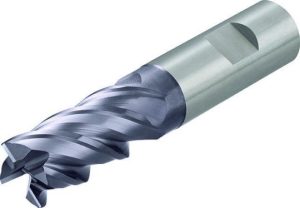
Choosing a suitable end mill before starting your job can be a pretty complex task. In the preponderance of CNC milling machine service providers, end mill tools are often employed. Many variables must be analyzed, such as end mill geometry, length, profile type, and material, while many trades-offs have to be considered:
- Performance
- Tariff
- Surface finish
- Tool life
What is an end mill? Is it like a drilling tool? It is a valid question that comes to mind, but the answer is no.
End mills are mostly used to make complicated geometries by removing material laterally and producing slots or detailed profiles. In addition, a lot of end mills are made for center-cutting. When employing end mill cutters, the following three considerations should be taken into account:
- What type of material do you want to mill?
- What kind of geometry do you want to mill?
- What is your aim in terms of accuracy and quality?
Spot drilling

Spot drilling is prioritized to ensure the accurate drill location and avoid drill deviation. Spot drilling is recommended when a drill might tend to move off center and requires deep-hole drilling.
It is designed to be highly rigid to spot a hole for a twist drill accurately. It typically has a tight tolerance point geometry with an abridged flute length. It also improves the precision of secondary drill operations, and they can be used as a chamfering tool if the final hole size is smaller than the spot drill diameter. The spot drill diameter should be about 70% of the size of the final drill diameter, and the spot drill point angle must be greater than your final’s drill point angle.
Center drill
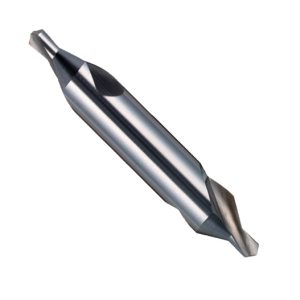
A center drill is made of a high-carbide material commonly used for metalworking. It is a shorter, thicker drill with a tapered or cone-shaped end that is much thinner than the shank of a drill. It does not grab the surface being drilled. It is also referred to as a combined or countersink drill. It is used to make holes by drilling in the axis of the shaft to hold it between centers on different CNC lathes. Center drill is mainly divided into two types, and these are as follows:
- Type A (creates a center hole with a single 60-degree chamfer)
- Type B (forms a hole with two chamfers, one at 60 degrees and an additional 120-degree chamfer at the start of a spot).
Drill bits (standard twist drill)
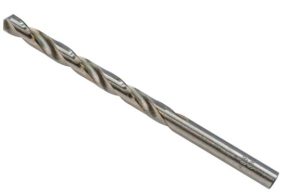
A twist drill is the most common type of drill bit. It has a cylindrical shape with deep helical grooves across its length. It consists of three main components, i.e. shank, body, and drill point. It is used to drill holes in different hard materials, such as:
- Plastic
- Wood
- Steel
Twist drill bits are often used for metal cutting and are composed of high-speed steel (HSS). Different types of coatings are favored to improve the life of twist drills and these are listed below:
- Bright finish
- Black oxide
- Titanium nitride
- Titanium aluminum nitride
Face milling cutter
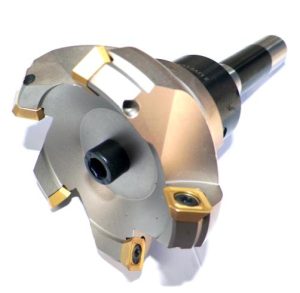
CNC face milling is a production technique. Using cutting tools, raw materials are removed from a workpiece. The selection of tools for a face milling manufacturing process has intricacies to consider and is probably the fascinating part. Let’s look at several face milling cutter types and entrance angles:
- Endmill
- Ball cutter
- Slab mill
- Side and face cutter
- Fly cutter
- Hollow mill
- Roughing end mill
End mills, face mills, and fly cutters are the most used milling tools for face milling operations. Other technological activities can serve such cutters, but only as ancillary tooling.
T-shaped knife
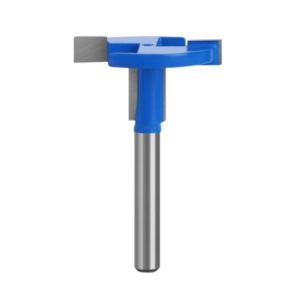
In the manufacturing industry, CNC knife-cutting tools are generally utilized. It is intended to cut metal sheets, plastic, pipes, rods, bars, and other similar hard materials. CNC knife-cutting tools are used in the aerospace, automotive, and shipbuilding industries. The CNC knife tool’s main goal is to accomplish the job swiftly and accurately with minimal human intervention. When it’s necessary to remove hard or heavy material, the tangential-shaped knife is preferable. It removes a portion of the material, retracts upwards, and swiftly returns. This reduces the strain that builds up around the blade, lowering the risk of ripping the material and improving the blade’s life.
Bullnose End Mill
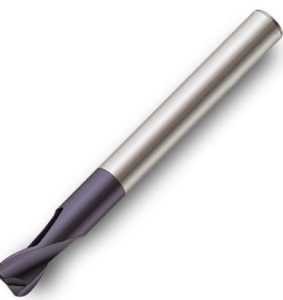
Bullnose end mills are also known as bull end mills or corner radius end mill cutters. It is a single-ended tool used for making corner radii at the edge of a milled shoulder. It has more robust milling edges than square-end mills. Therefore, the feed rate may be increased gradually and enhances productivity. It is mainly used in mold profiling applications (Aerospace and automotive industry) with a greater production rate. It is available in many sizes and lengths and is generally made up of solid carbide.
Some of the essential parameters while selecting the suitable bull nose cutter are listed below:
- Corner radius
- Cutter diameter
- Number of flutes
- Coating material
- Shank diameter
- Helix angle
Fine boring tool
Basic hole-making techniques include boring and drilling. First and foremost, drilling creates a hole in the workpiece that is precisely enlarged by a fine boring tool while keeping the integrity of the surface. Compared to milling machines, boring processes on CNC turning machines are simpler.
Ball knife
Solid carbide turnover knives are another name for ball knife cutting tools. It is ideal for projects with long run periods and offers tremendous cost savings. The major advantage is that if one side of the knife becomes rough, simply remove it, turn it over, and run that again.
Chamfer Mill

A small amount of material is removed from the edge of the workpiece by a process called chamfering. The cut is often performed at an angle, and the finished surface is referred to as a chamfer. When a smooth chamfered surface is desired, a two-dimensional chamfer is chosen.
Below is a list of a few machining centers that offer various milling processes:
- CNC milling machine
- CNC Bed mill
- Horizontal and vertical CNC machining centers
- Multi-axis CNC milling machine
Conclusion
After reading this article, I hope you have sound knowledge to search and choose the best CNC machining tools in light of in-depth engineering knowledge. The proper utilization of CNC machines and tooling is essential in producing new products as the world advances daily in all fields. It simply involves putting together the best combination to select the ideal CNC tool based on the situation and optimize your strengths.
Worthy Hardware is a CNC manufacturing and sheet metal fabrication company,including CNC machining services,CNC milling services, CNC turning services, laser cutting services and stamping services.Call us +86-76989919645 or email us [email protected] for more discounts for your projects.

